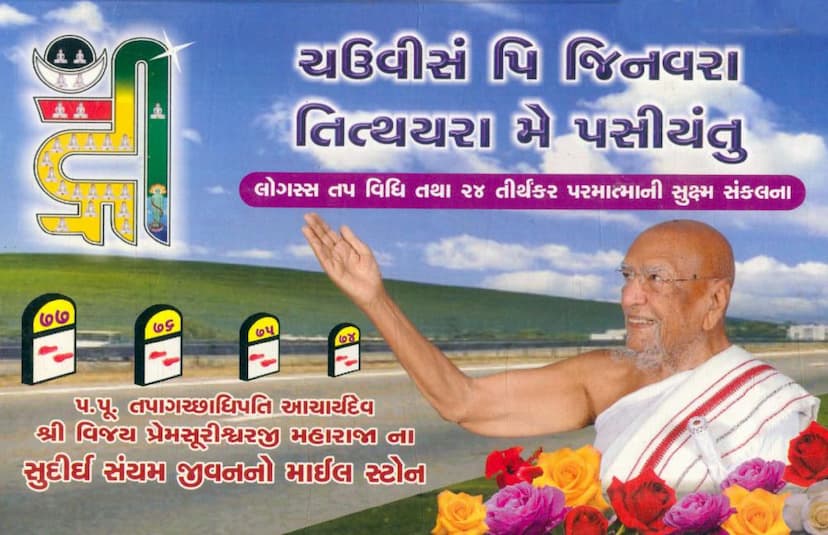Chauvisam Pi Jinvara Titthayara Me Pasiyantu
Added to library: September 1, 2025

Summary
Here's a comprehensive summary of the Jain text "Chauvisam Pi Jinvara Titthayara Me Pasiyantu" based on the provided pages:
Book Title: Chauvisam Pi Jinvara Titthayara Me Pasiyantu (Twenty-Four Tirthankaras, May They Be Pleased with Me)
Author(s): 108 Parshwanath Bhaktivihar Jain Trust
Publisher: 108 Parshwanath Bhaktivihar Mahaprasad - Shankheshwar Tirtha & Shri Pavapuri Jalamandir Shri Guru Prem Dham - Panchasar, Shri Vardhaman Bhakti Jain Sangh - Ahmedabad.
Overall Theme: This book is a devotional compilation dedicated to the twenty-four Tirthankaras of the current era (Vartaman Chaubisi). It serves as a guide and resource for Jain devotees, particularly focusing on the "Logassa Tap" (a specific Jain penance) and the veneration of the Tirthankaras. The underlying theme is deep devotion, spiritual learning, and adherence to Jain principles.
Key Components and Content:
- Title and Purpose: The title itself, "Chauvisam Pi Jinvara Titthayara Me Pasiyantu," expresses a prayer for the pleasure and grace of the twenty-four Tirthankaras. The book aims to provide a refined compilation of the "Logassa Tap vidhi" and detailed information about the twenty-four Tirthankaras.
- Inspiration and Dedication: The book is published under the auspices of Acharya Shri Vijay Premsurishwarji Maharaj, a highly revered spiritual leader. It is dedicated to several significant occasions and individuals:
- The collective observance of "Logassa Tap" by about 100 devotees during a Chaturmas (a four-month period of spiritual retreat).
- The 77th anniversary of Acharya Shri Vijay Premsurishwarji Maharaj's spiritual life.
- The first anniversary of Acharya Shri Vijay Hemchandrasurishwarji Maharaj's ascension to the Acharya-ship.
- The well-being of respected Munishri Virvijayji Maharaj (father of Acharya Shri Vijay Hemchandrasurishwarji) and Munishri Bhaktiratna Vijayji Maharaj.
- The well-being of Daneshwari Shrestivar Shri Navnitbhai Manilal Shah.
- To provide spiritual knowledge about the 24 Tirthankaras to young monks.
- Spiritual Guidance and Practices:
- Logassa Tap: The book elaborates on the "Logassa Sutra" and its significance in spiritual practice, particularly within the context of "Upadhan Tap" (a rigorous penance). It explains the importance of chanting the Navkar mantra and the subtle connections between "Om" and "Shri."
- Chaitra Vandan: Prayers and verses for venerating the Tirthankaras are included.
- Mantra Japa: Specific mantras for each of the 24 Tirthankaras are provided.
- Spiritual Insights: The text delves into the significance of the number 24 in Jainism, its connection to the 24 Tirthankaras, and the natural arrangement of their representations in a palm.
- Philosophical Explanations: There are discussions on the relationship between "Om" and "Shri," the significance of the 7 in relation to the 24 Tirthankaras, and the deeper meanings within Jain scriptures.
- Detailed Information on the 24 Tirthankaras:
- The book provides an extensive profile for each of the 24 Tirthankaras, starting with Shri Adinath Bhagwan (Page 28 onwards) and continuing through the entire lineage.
- Each profile includes:
- Parentage and Lineage: Father, Mother, Dynasty (Vansh), Gotra.
- Life Events: Birth, Kumar Avastha (youth), Rajya Avastha (kingdom), Marriage status, Diksha (renunciation), Keval Gyan (omniscience), Nirvana (liberation).
- Symbolism: Lanchhan (emblem), Shasan Yaksha (attendant deity), Shasan Yakshini (attendant goddess), Physique (height, color), Auspicious dreams.
- Past Lives: Information about previous births, including names, cities, gurus, and deities.
- Spiritual Details: Details about lifespan, celestial abodes from which they descended, significant events during their life, disciples, prominent devotees, and spiritual attainments.
- Devotional Content: Sanskrit, Hindi, Marathi, Gujarati, and English stutis (hymns), prayers, stanzas, and Chaitya Vandan (temple prayers) dedicated to each Tirthankara.
- Key Places: Information about prominent pilgrimage sites associated with each Tirthankara.
- Jain Navagraha Shanti Jaap: Mantras related to planetary pacification within Jainism.
- Panch Kalyanaka: Detailed descriptions of the five auspicious events in the life of each Tirthankara (Chyavan, Janma, Diksha, Keval Gyan, Nirvana).
- Kavya Vibhag (Poetic Section): Includes Chaitya Vandan, Thoy (short verses), Stavan (devotional songs), Sandhya Bhakti (evening prayers), and communal stutis.
- Sangeet (Music Section): Discusses the scientific basis of music, classical ragas, their associated times for singing, and their connection to disease treatment.
- Yantra and Mantras: The book includes diagrams of Yantras and specific mantras for various purposes, including the powerful "Logassa Sutra" mantras.
- Numerological and Symbolic Significance: There is an emphasis on the significance of numbers like 7 and 24 within Jainism, linking them to the Tirthankaras and their attributes.
- Illustrations and Visuals: The pages feature numerous images of Tirthankara idols, yantras, and symbolic representations, enhancing the devotional and learning experience.
- Auspicious Occasions: The book is presented as a medium to foster devotion and spiritual growth, celebrating important milestones in the lives of revered Gurus and monks.
Key Gurus and Supporters:
- P.P. Acharya Dev Shrimad Vijay Premsurishwarji Maharaj: The guiding light and inspiration.
- P.P. Jain Jyotishacharya Shri Vijay Hemchandrasurishwarji Maharaj: Disciple and key contributor.
- Muni Shri Bhakti Ratna Vijayji Maharaj (Bapu Maharaj): Direct disciple and compiler.
- Shri 108 Parshwanath Bhaktivihar Mahaprasad, Shri Pavapuri Jalamandir, Shri Guru Prem Dham, Shri Vardhaman Bhakti Jain Sangh: Publishers and supporters.
- Smt. Jasudben Manilal Lallchand Shah Family (Mumbai): Major benefactor.
- Shri Nemiprinters, Ahmedabad: Printers.
Overall Purpose and Value: "Chauvisam Pi Jinvara Titthayara Me Pasiyantu" is a comprehensive and visually rich guide for Jain followers. It aims to deepen understanding and devotion towards the twenty-four Tirthankaras, provide practical spiritual guidance through the "Logassa Tap" and other practices, and serve as a valuable reference for Jain philosophy, history, and rituals. The meticulous detail provided for each Tirthankara highlights the importance of individual veneration within the broader framework of Jain faith.